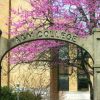calsfoundation@cals.org
John Miller Howard (1908–1980)
John Miller Howard was an African-American artist and arts educator who founded the Art Department and taught at Arkansas AM&N—now the University of Arkansas at Pine Bluff (UAPB)—from 1939 until his death in 1980. At AM&N, he worked to provide a top-quality arts education to his students, many of whom came from rural backgrounds and lacked exposure to art. Howard was recognized as a gifted painter and teacher. His life and work form an important chapter in the history of art in Arkansas.
John Miller Howard was born in Alcorn, Mississippi, on September 22, 1908, to Lillie Howard, a young single mother who nurtured his early talent for drawing. He grew up in Brookhaven, Mississippi, attending segregated schools. He graduated from Alcorn College in 1934. Although the college had no art department, Howard developed his natural talent by painting murals and signs, designing floats, and drawing for the school newspaper. He also did some of this work for other schools to make money. An excellent baseball player, he played for the Alcorn College team and also played minor league baseball around the United States and in Mexico.
Howard’s first professional job was as principal of the black school in Toomsuba, Mississippi. There, he worked not only with the school, but also as a kind of public health officer, building outhouses, developing sources of clean drinking water, and lecturing on the prevention of disease. He also continued his work as a commercial artist. In 1936, he began working at T. J. Harris High School in Meridian, Mississippi. There, he was given a scholarship for summer study at Atlanta University.
In Atlanta, Howard studied under the well-known artist Hale Woodruff, who became a lifelong friend and advisor. He recognized Howard’s talent and invited him back to Atlanta in 1937 to study with a scholarship and a job teaching at the Laboratory High School, which was affiliated with the university. Howard thrived there. He developed his painting and teaching skills and became part of a network of talented young artists mentored by Woodruff. He assisted in creating Woodruff’s historic mural, The Amistad.
In 1939, AM&N president John Brown Watson recruited Howard to found an art department at the school, and Howard moved to Pine Bluff (Jefferson County). Except for a year of study in New York during 1948–49, after which he received a master’s degree in art education, he spent the rest of his life in Arkansas.
Many of his students developed successful careers in art. Nationally known artists Jeff Donaldson and Kevin Cole graduated from his program. Chicago muralist Mitchell Caton also studied with Howard at AM&N. For many years, Howard was also director of public relations at AM&N. He created imaginative floats and decorations for student parades. In 1967, he convinced the Arkansas Higher Education Commission to fully fund the $1.4 million Fine Arts Center at AM&N—then the costliest structure in AM&N history.
Howard’s career as an exhibiting painter continued. In 1946, he was awarded first place in the Arkansas Artists Exhibition for his painting The Old Lady with a Letter and a Picasso. Controversy ensued over the prize being awarded to an African American, and a second first-place prize was created to quiet the protest. Howard also won the John Hope Award in the National Negro Artists Exhibition in 1950 for his work Arkansas Landscape. Throughout his life, he continued exhibiting in state and national art shows.
Howard’s significance as a cultural figure was recognized by many fellow Arkansans. He was a friend and correspondent of the poet John Gould Fletcher and the painter Louis Freund. From 1950 to 1956, he taught summer courses in art education at the University of Arkansas Graduate Center in Little Rock (Pulaski County), where somewhat contorted arrangements had to be made for an African American without a doctorate to teach a graduate class.
Among numerous honors and appointments, Howard served on the Arkansas Advisory Council on Secondary Education and on the Arkansas Arts, Culture and Humanities Council. He was listed in the 1970–71 edition of Outstanding Educators of America and was chosen as one of sixteen Distinguished Artists in Arkansas in 1974. In 1978, he was listed in Who’s Who in American Art.
Howard married Julia Palmer, a librarian at AM&N, in 1941. They had two daughters, Roselily and Marinelle. Julia Palmer Howard died on June 3, 1971. Despite having a stroke in 1971, Howard returned to AM&N in 1974, where he continued to work until his death on October 10, 1980.
A retrospective of Howard’s work, curated by his friend June Freeman, was presented in 1981 at the Arts & Science Center for Southeast Arkansas. The exhibition traveled to the Winthrop Rockefeller Institute in 1982. Most of Howard’s work is on permanent loan to UAPB.
For additional information:
Albin, Edgar A. “AM&N Artist’s Work Marked by Power, Versatility.” Arkansas Gazette, July 8, 1962, p. 4E.
“John M. Howard, Noted Artist, Ex-Professor Dies at Age 70.” Arkansas Gazette, October 12, 1980, p. 24A.
“John Miller Howard, 1908–1980.” Morrilton, AR: Winthrop Rockefeller Institute, 2010.
Unpublished autobiography of John Miller Howard. On file at University of Arkansas at Pine Bluff Museum and Cultural Center, Pine Bluff, Arkansas.
Sarah Leflar
Fayetteville, Arkansas
 Education, Higher
Education, Higher World War II through the Faubus Era, 1941 through 1967
World War II through the Faubus Era, 1941 through 1967




Comments
No comments on this entry yet.